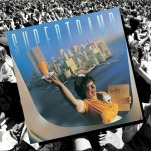The New Cult Canon: I Am Cuba
When
Mikhail Kalatozov's I Am Cuba—a long-lost, phantasmagoric Cuban-Soviet propaganda
film from 1964—was rediscovered and reissued in late 1995 by Milestone
(with the prominent support of Martin Scorsese and Francis Ford Coppola),
critic Terrence Rafferty wrote the following in his New Yorker review: "They're going to be
carrying ravished film students out of the theaters on stretchers."
That's
about right. Personally speaking, I certainly needed medical assistance to
reattach my jaw, which had dropped permanently to the floor during one of the
film's famed tracking shots. Though I Am Cuba is fascinating enough as an historical
footnote—and I'll get into that in a second—the reason it endures
is almost exclusively cinematic: Given the virtually unlimited resources of two
countries at their disposal, Russian director Kalatozov (The Cranes Are
Flying) and his
cinematographer Sergei Urusevsky turned the newly Communist Cuba into a lush
playground where they could experiment with wide-angle lenses, whooshing camera
moves, and towering crane shots held for minutes at a time. Their assignment
was to affirm the revolutionary spirit that had just given birth to a new Cuba,
but within those broad parameters, they were free to pull off all the technical
wonderments they could dream up. After all, in a movie where the country itself serves as voiceover narrator,
there's no danger in getting bogged down in the particulars of character.
Why did it
take a film as striking as I Am Cuba so long to get rediscovered in America? Partly because
nobody knew to discover it. By 1964, the U.S. had severed all diplomatic and
trade relations with Fidel Castro's government, and in doing so, severed the
cultural exchange between the two countries as well. (A shot of a "Cinerama"
theater in a city backdrop in I Am Cuba suggests the impact Hollywood movies once had there,
as does a sequence set in a Batista-era drive-in.) Always eager to partner with
its new comrades—as the contemporaneous Cuban Missile Crisis would
attest—the Soviet government swooped in to co-produce a movie about the
Cuban revolution, and I Am Cuba was the strange, beautiful, misbegotten lovechild that
resulted from the marriage.
Unfortunately,
the completed film tanked with both the Cubans and the Russians. The 2005
documentary I Am Cuba: The Siberian Mammoth—a solid primer on the film,
if not a particularly distinguished one—tracks down some of the crew
members on the arduous 14-month shoot, many of whom are baffled that the
project they remember as a total disaster has any appreciators at all.
Basically, the Cubans thought the camera pyrotechnics overwhelmed and distorted
the realities of the uprising, and leaned heavily on clichéd, simplistic portraits
of their people. On their end, the Soviets didn't care for the inadvertently
seductive portrait of Western excess in the film's early section. I'd argue
that both camps were completely right—and yet I Am Cuba is still magnificent.
Maybe the
problem is that revolutionary cinema probably plays better before the
revolution than after it, when people are done dreaming of a new, idealistic
world and have started living in the one that they've got. As such, I Am
Cuba is a bit like
a car salesmen who keeps making his pitch after a customer has driven the lemon off
the lot. Granted, a generation of Soviet silent filmmakers produced masterpieces
like Potemkin
and Earth after
the Russian Revolution, but those films were homegrown; Kalatozov, Urusevsky,
and Yevgeni Yevtushenko, the poet who co-wrote the script, were coming to Cuba
as outsiders to the culture, and the natives likely didn't appreciate the
condescension.
Nevertheless,
the four vignettes that comprise the film have a poetic simplicity, building from
personal hardships and tragedy to the triumphant movement of the collective.
The first and most affecting segment takes place in a decadent Havana, where
Westerners indulge in casinos, luxury hotels, and bars—and exploit
desperately poor locals willing to do anything to get by. This includes Maria,
a virginal beauty (with a giant crucifix around her neck, no less) who's
destined to marry a fruit vendor, but joins the legions of exotic prostitutes
at a Western bar. When a john insists they go back to her place—a
tin-roofed shack in a sprawling shantytown—we catch a glimpse of how
Havana's other half lives.
From there,
the other three segments depict Cubans taking action: The second features a
sugarcane farmer who takes drastic measures after losing his land and his home
to a fruit company. The third follows a student revolutionary who fails to
carry out a political assassination but summons the courage to rally the people
to disbelieve false reports of Castro's death and march against the
authorities. The last heads into the mountains, finding a farmer who leaves his
family behind to join the revolutionaries as they battle in the countryside and
forge their way, arm-in-arm, to a triumphant new day in the capital.





















![Rob Reiner's son booked for murder amid homicide investigation [Updated]](https://img.pastemagazine.com/wp-content/avuploads/2025/12/15131025/MixCollage-15-Dec-2025-01-10-PM-9121.jpg)


















